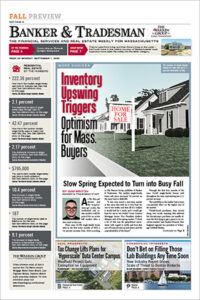
Sarah Gustafson
This past February, a representative of the Massachusetts Association of Realtors stood alongside Gov. Maura Healey, Secretary of Housing and Livable Communities Ed Augustus and numerous housing advocates for the release of the commonwealth’s five-year housing plan. The report was drafted by the Housing Advisory Council in order to serve as the commonwealth’s first-ever statewide housing plan.
The Housing Advisory Council was established in 2024 by the governor. MAR General Counsel and Director of Government Affairs Justin Davidson, served on the council alongside Lt. Gov. Kim Driscoll, Secretary Augustus and 19 other housing advocates and public officials. The council met in person and virtually, in addition to hosting fourteen listening sessions in every corner of the state.
It is well known that Massachusetts is facing a housing crisis that affects residents across the state. The rising cost of housing, low housing supply, and affordability challenges have created instability for many households, limiting economic growth and community well-being. In response, the Healey-Driscoll administration sought to develop the most comprehensive statewide housing plan in the commonwealth’s history, focusing on creating, preserving and expanding housing opportunities for all residents.
As part of the report, the Executive Office of Housing and Livable Communities (EOHLC) completed a Housing Needs Assessment. Over the one-year process to develop the Housing Plan, EOHLC and its consultant team conducted extensive research, data collection and forecasting.
Housing Needs Takeaways
The report estimates that Massachusetts needs 222,000 additional housing units by 2035 to address the current shortage and projected demand. That is the number of homes needed to accommodate our current population as it ages, to reduce overcrowding and homelessness and retain a strong labor force.
Massachusetts’ vacancy rate is at a historic low of 1.6 percent, creating fierce competition for unoccupied units. Each year from 2010 through 2020, the state added an average of 19,000 units, but in 2023, only 11,600 homes were issued building permits.
Median home sale prices have surged 73 percent since 2000, while inflation-adjusted household incomes have risen only 4 percent. The number of households paying more than 30 percent of their income has risen across all income groups. More than one quarter of middle-income households and more than three quarters of low-income households are cost burdened.
Homelessness is on the rise, with Massachusetts now having the fifth-largest homeless population in the nation.
Strategies to Meet State’s Needs
Achieving a state of housing abundance in Massachusetts will require a multifaceted approach that both accelerates new housing production and protects existing homes.
Increasing as-of-right zoning capacity for multifamily housing, particularly under the MBTA Communities law, will help unlock development in the areas well-connected by transit. Additionally, deploying resources from the Affordable Homes Act will be critical to ramping up the production and preservation of affordable rental housing across the state.
Equally important is protecting existing homes and maintaining affordability, which includes allocating $2.2 billion for the repair and rehabilitation of public housing and increasing funding for home rehabilitation programs to ensure Massachusetts maintains a safe and affordable housing stock for the long term.
Supporting households in Massachusetts not only means expanding access to housing, but also strengthening the resources that help residents thrive. Increasing funding for homeownership programs, particularly for first-time home buyers in Gateway Cities, can help close the racial wealth gap and foster long-term economic stability.
Creating a more affordable and livable Massachusetts requires a united effort. By partnering with cities and towns, the commonwealth can foster local participation in housing development initiatives, ensuring solutions reflect community needs and priorities. Collaborating with private developers, nonprofits and community organizations will help boost housing production across the state. Together, these partnerships are key to building the homes Massachusetts residents need and will strengthen communities for the long term.
A United Path Forward
Massachusetts is at a critical juncture. Addressing the housing crisis requires bold action, collaboration and sustained investment. Combining the work of the Housing Advisory Council with the Unlocking Housing Production Commission provides the awareness, policies and next steps needed to take on our housing crisis.
The Unlocking Housing Production Commission’s report, Building for Tomorrow, provides recommendations across four broad themes: Economic incentives and workforce development in the housing industry; updating land use and zoning practices; streamlining regulations, codes, and local permitting; and bolstering state planning and local coordination.
MAR is proud to be a partner to the Healey-Driscoll administration and thanks the administration for recognizing the important input and perspective that Realtors can provide in shaping the housing policy of the commonwealth. The state’s housing plan will lay the foundation for a future in which every resident has access to safe, stable and affordable housing. We have the plan and the tools, but now we all need to work together to implement them and continue to move Massachusetts forward.
Sarah Gustafson is the 2025 president of the Massachusetts Association of Realtors and a Realtor and Broker with Keller Williams Pinnacle Central in Worcester & Metrowest in Westborough.





